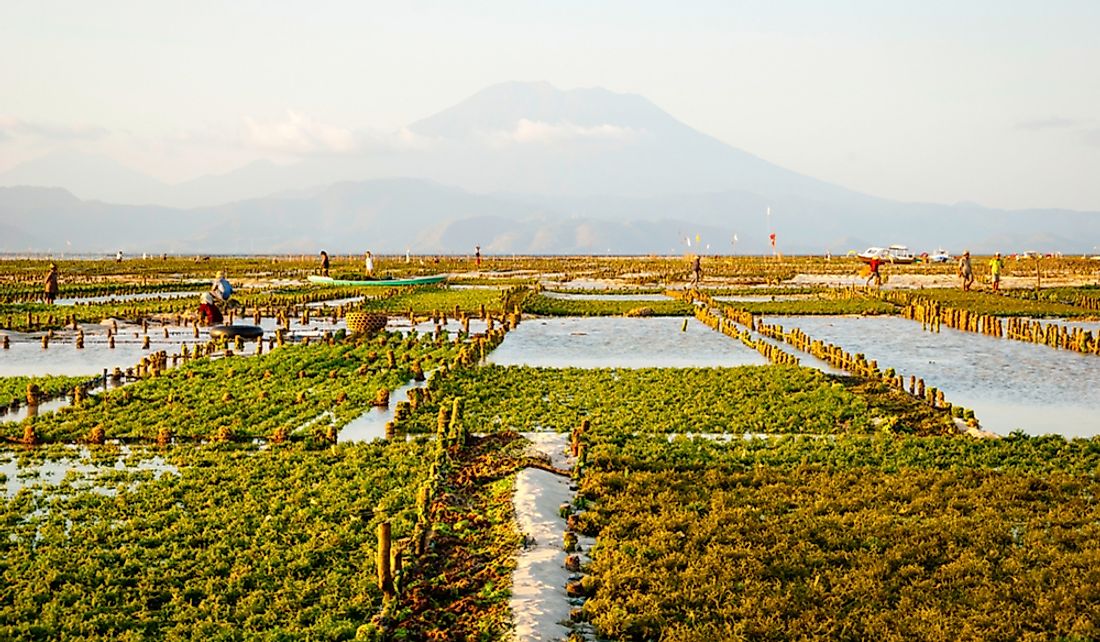What Is The Economic Importance Of Algae?

Algae refers to a wide range of eukaryotic marine organisms, all of which engage in the process of photosynthesis. Ranging in size from unicellular microalgae to giant kelp, these aquatic plants are characterized by their lack of flowers, formal roots, leaves, or even stems. Algae are economically important in a variety of ways. The natural substance can be used as a food source, a fodder, in fish farming, and as a fertilizer. It also plays a key role in alkaline reclaiming, can be used as a soil binding agent, and is used in a variety of commercial products.
Uses for Algae
Food
Numerous cultures around the world consider algae an important source of nourishment. Citizens living in European countries such as Ireland, Scotland, France, Germany, Norway, and Sweden, as well as populations living in North and South America, and Asian nations such as China and Japan use algae as a key ingredient in a number of local dishes. These meals can include algae as part of a salad, accompanying meat in a fried dish, as a topping on oatmeal, or even in liquid form as an extract in a nutritious smoothie.
Algae contains several healthy elements including carbohydrates, fats, proteins, and vitamins A, B, C, and E. Not only is algae considered by many consumers worldwide to be a low cost source of protein, but it also contains a number of important minerals such as iron, potassium, magnesium, calcium, manganese, and zinc. Foods which commonly contain algae include a variety of dairy products such as milk, ice cream, cheese, whipped topping, as well as syrup, icing, fruit juice, and even salad dressings. Brown algae, in particular, is used in order to stabilize, thicken, and emulsify numerous food products, while red algae is used in the preparation of various semi-solid products as wide-ranging as medicines, cosmetics, and in the production of a wide array of foods.
Fodder
Algae, especially seaweed, is used as a feed for a variety of farm animals. For example, Rhodymenia palmate, or so-called "Sheep’s weed," is used in order to feed livestock such as cattle and chickens. Algae is used as fodder in various countries, such as the northern European nations of Sweden, Denmark, and Norway, as well as in Scotland, China, New Zealand, and throughout North and South America.
Pisciculture
The industry involved in the breeding and farming of fish, also known as fish farming or pisciculture, also utilizes algae as part of its production process. According to scientists, numerous species of fish like to consume a variety of types of algae, the most common sources being blue-green and green algae, as well as with microalgae. Fish usually feed on floating plankton and zooplankton, which provides a source of healthy vitamins. Algae is also used in pisciculture as a way in which to naturally absorb carbon dioxide from the environment, while at the same time providing oxygen to the water, thus making the marine environment more habitable for fish.
Fertilizer
The two most common varieties of algae used in the manufacture of fertilizer are large red and brown. In particular, these two types of algae are utilized in areas located near the ocean. Liquid fertilizer can also be produced using a concentrated seaweed extract. The reasons why this type of fertilizer is so popular involves the organism’s ability to repair levels of nitrogen already present in the soil. For example, rice producers in India typically employ blue-green algae in order to fertilize their agricultural fields.
Reclaiming Alkaline
In many countries, such as India, fields that once produced large agricultural yields can no longer be used due to high concentrations of alkalinity in the soil. In order for crops to eventually be grown in these lands, often referred to as "Usar" lands, the ph level must be lowered and the ability of the soil to hold onto water must be increased. This process can be achieved using blue-green algae.
Binding Agent
Algae can also be used to help bind soil together. The use of algae to aid in the healthy formation of soil is important in the protection against natural processes such as erosion.
Algae Products
Algae is used as a key ingredient in various food products. The substance can either be used as an additive or can act as a thickener in many types of food products. Algae can also be found in household products, such as toothpaste and various pharmaceuticals. A type of algae, known as carrageenan, is often added to dairy products such as cheese and sour cream in order to give them a denser texture. Alginic acid, which can be found in algae, is used to stabilize foods such as milkshakes, malts, and mayonnaise. Consumers might also be familiar with the green paper-like sheets used to wrap sushi. This product, called nori, is actually a leafy form of algae which was traditionally grown in Japan and contains plenty of healthy nutrients and assorted vitamins.
Gelatin is used in the production of numerous edible products. In fact, this substance is made up of a type of algae known as agar. Purportedly first used in 17th century China, gelatin acts to solidify liquids found in such popular products such as pie crusts and fillings.
Purple-colored algae, also known as Porphyra, is commonly used in Japan and is known as nori, which is used to wrap up sushi rolls. In Korea, this same substance is known as gim. In Wales, this type of algae is referred to as laverbread, which is traditionally served for breakfast along with bacon and cockles (a type of mollusk). In Ireland, residents stew or boil the algae, thus making it into a pink colored jelly.
In the manufacturing of toothpaste, algae is used in order to thicken what would otherwise be a runny substance and transform it into a partially solid form. This particular form of algae is safe to consume and dissolves during the tooth brushing process.











